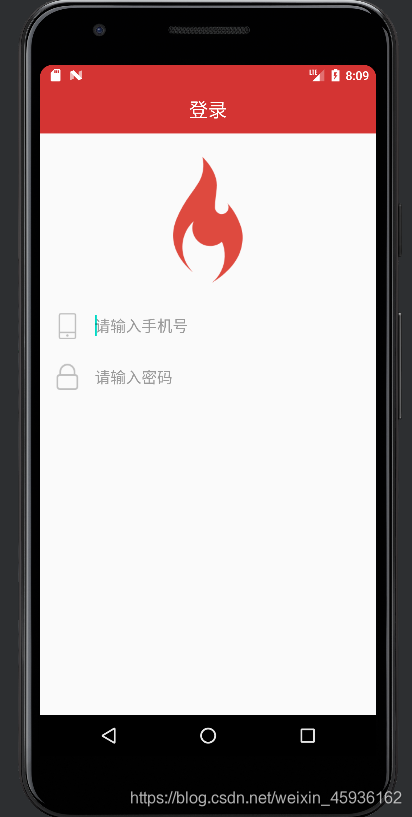写在前面
在写程序的过程中,我们会遇到重复写很多代码的问题,今天我们使用自定义控件进一步步提升效率。
 ,
,
正常我们写这么一个页面的输入框那些,每个都需要下面这些代码。
<LinearLayout
android:layout_width="wrap_content"
android:layout_height="44dp"
android:gravity="center_vertical"
android:paddingLeft="16dp"
android:paddingRight="16dp">
<ImageView
android:id="@+id/iv_icon"
android:layout_height="wrap_content"
android:layout_width="wrap_content"
android:src="@mipmap/phone"/>
<EditText
android:id="@+id/et_input"
android:layout_width="match_parent"
android:layout_height="match_parent"
android:background="@null"
android:hint="用户名"
android:paddingLeft="@dimen/marginSize"
android:paddingRight="@dimen/marginSize"
android:textSize="@dimen/titleSize"/>
</LinearLayout>
自定义控件
设置
[value/arrts.xml]
<?xml version="1.0" encoding="utf-8"?>
<resources>
<!-- 声明样式 -->
<declare-styleable name="inputView">
<!--输入框前面的小图标-->
<attr name="input_icon" format="reference"></attr>
<!--输入框的提示内容-->
<attr name="input_hint" format="string"></attr>
<!--输入是否需要以密文展示-->
<attr name="is_password" format="boolean"></attr>
</declare-styleable>
</resources>
[value/input_view]
<?xml version="1.0" encoding="utf-8"?>
<LinearLayout xmlns:android="http://schemas.android.com/apk/res/android"
android:layout_width="match_parent"
android:layout_height="@dimen/inputViewHeight"
android:orientation="horizontal"
android:gravity="center_vertical"
android:paddingLeft="@dimen/marginSize"
android:paddingRight="@dimen/marginSize"
>
<ImageView
android:id="@+id/iv_icon"
android:layout_height="wrap_content"
android:layout_width="wrap_content"
android:src="@mipmap/phone"/>
<EditText
android:id="@+id/et_input"
android:layout_width="match_parent"
android:layout_height="match_parent"
android:background="@null"
android:hint="用户名"
android:paddingLeft="@dimen/marginSize"
android:paddingRight="@dimen/marginSize"
android:textSize="@dimen/titleSize"/>
</LinearLayout>
[java/views/inputView.java]
继承FrameLayout->重写方法,然后在下面定义初始化这些方法
package net.tyao.imoocmusicdemo.views;
import android.content.Context;
import android.content.res.TypedArray;
import android.os.Build;
import android.text.InputType;
import android.util.AttributeSet;
import android.view.LayoutInflater;
import android.view.View;
import android.widget.EditText;
import android.widget.FrameLayout;
import android.widget.ImageView;
import androidx.annotation.NonNull;
import androidx.annotation.Nullable;
import androidx.annotation.RequiresApi;
import net.tyao.imoocmusicdemo.R;
/***
* 1、input_icon 输入框前面的小图标
* 2、input_hint 输入框的提示内容
* 3、is_password 输入的内容是否需要以密文形式显示
*/
public class inputView extends FrameLayout {
private int inputIcon;
private String inputHint;
private boolean isPassword;
private View mView;
private ImageView mIvIcon;
private EditText mEtInput;
public inputView(@NonNull Context context) {
super(context);
init(context, null);
}
public inputView(@NonNull Context context, @Nullable AttributeSet attrs) {
super(context, attrs);
init(context, attrs);
}
public inputView(@NonNull Context context, @Nullable AttributeSet attrs, int defStyleAttr) {
super(context, attrs, defStyleAttr);
init(context, attrs);
}
@RequiresApi(api = Build.VERSION_CODES.LOLLIPOP) //android 5.0以上才可以使用
public inputView(@NonNull Context context, @Nullable AttributeSet attrs, int defStyleAttr, int defStyleRes) {
super(context, attrs, defStyleAttr, defStyleRes);
init(context, attrs);
}
private void init(Context context, AttributeSet attrs) {
if (attrs == null) return;
// 获取自定义属性
TypedArray typedArray = context.obtainStyledAttributes(attrs, R.styleable.inputView);
inputIcon = typedArray.getResourceId(R.styleable.inputView_input_icon,R.mipmap.logo);
inputHint = typedArray.getString(R.styleable.inputView_input_hint);
isPassword = typedArray.getBoolean(R.styleable.inputView_is_password, false);
typedArray.recycle(); //使用完成后记得释放
// 绑定layout布局
mView = LayoutInflater.from(context).inflate(R.layout.input_view,this,false);
mIvIcon = mView.findViewById(R.id.iv_icon);
mEtInput = mView.findViewById(R.id.et_input);
// 布局关联属性
mIvIcon.setImageResource(inputIcon);
mEtInput.setHint(inputHint);
mEtInput.setInputType(isPassword ? InputType.TYPE_CLASS_TEXT | InputType.TYPE_TEXT_VARIATION_PASSWORD : InputType.TYPE_CLASS_NUMBER);
addView(mView);
}
/***
* 获取输入内容
* @return
*/
public String getInputStr() {
return mEtInput.getText().toString().trim();
}
}
使用
<net.tyao.imoocmusicdemo.views.inputView
android:layout_width="match_parent"
android:layout_height="@dimen/inputViewHeight"
android:layout_marginTop="@dimen/marginSize"
app:input_icon="@mipmap/phone"
app:input_hint="请输入手机号"
></net.tyao.imoocmusicdemo.views.inputView>
总结
可能这看起来写的比较多,但是到了后面可以直接使用,如果遇到很多这种,写起来就方便很多。